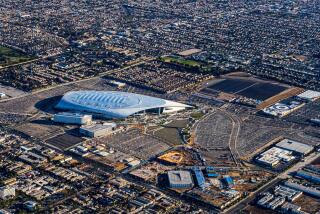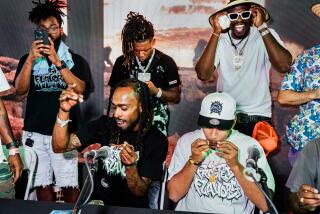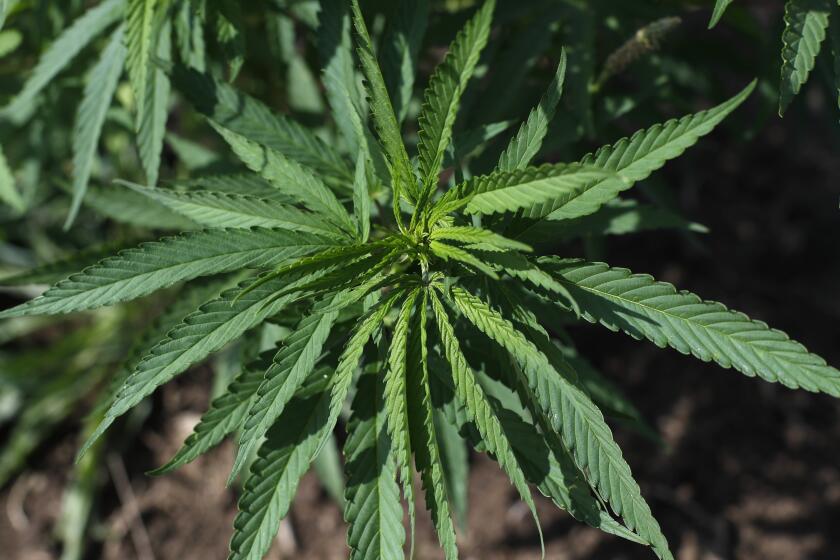Dancing Until Dawn
ADELANTO, Calif. — On most nights, the darkness and dust that cloak U.S. 395 in this tiny high-desert town are pierced only by the headlights of passing big rigs and the glowing red-and-white sign of the new Dairy Queen. So it was easy to imagine locals rushing to their porches on a recent Saturday night when green laser beams strafed the sky and a throbbing pulse began echoing above the desert winds.
The origin of the eerie commotion could be found at the pitcher’s mound of the city’s baseball field, where a nest of special-effects machines and speakers had, for one night, replaced the national pastime. Now the ballpark belonged to one of those mysterious, fleeting festivals of youth known as a rave party, a singular marathon of electronic music and sensory overload that thrills its followers and terrifies parents and authorities.
This rave would follow the form of most: a mass of fancifully dressed young people, many brimming with the giddy high of drugs such as Ecstasy, dancing madly until dawn to dense bass and beats at a remote site. The average age? About 17. This one drew about 6,000 ravers, but in recent weekends others have pulled in triple that number. The scene’s music, graphic designs and fashions are percolating into mainstream culture, but for the most part the rave phenomenon remains well below the radar of the general populace. Until there’s a casualty.
“Yeah, as soon as I heard about those kids driving off the mountain I knew people would be giving us grief again,” said a 17-year-old raver from Riverside who identified himself only as “Racer X.” He was referring to the five young people who died last month when their car plunged off the Angeles Crest Highway in the San Gabriel Mountains. The group had been on the way home from a rave at a ski resort, and their autopsies turned up traces of Ecstasy and speed.
“People hear that,” Racer X continued, “and they think raves are all about drugs. It’s really about the music, about the love and dancing.”
Racer X’s pupils were twitching as he said this, and like many others at the ballpark, he was chomping on a plastic baby pacifier, a de rigueur totem among the ravers that eases the teeth-grinding side effects of Ecstasy. He also had a surgeon’s mask slathered with Vick’s VapoRub, which some say enhances the drug’s high. He smiled when asked if he was “dosing.” “Hell yeah, man, everybody is.”
Here, from the mouth of Racer X, are the conflicting assessments of raves, which are approaching a vigorous 10th anniversary in Southern California.
To the scene’s faithful, it is a celebration of cyber-hippie ideals and a forum for a genre of music that may be the most exciting and least commercial outpost on the pop music landscape.
To the scene’s foes, however, it is nothing more than an elaborate ritual for young people to explore drugs and debauchery. And, perhaps worse, it often takes them to distant, dangerous locales to do so and leaves them bleary and spent when it’s time to drive home at dawn’s light.
“Without Ecstasy, most of these events would not exist, no doubt about it,” said consultant Trinka Porrata, a former LAPD narcotics investigator whose rave expertise is now focused on helping federal lawmakers curb the scene’s drug use. “I’d estimate that 80% of most rave crowds are using Ecstasy or another drug. . . . They’re not driving hundreds of miles for the music.”
One thing both sides seem to agree on is that the rave is not going away. After a lull a few years ago, the all-night dances are mounting a comeback, and in fact have grown so popular that they have evolved from ragged, outlaw events into quasi-concerts, with permits, big budgets, vendors and security teams. Rave fashions and music are also becoming staples in American malls, films and television commercials as touchstones of the new youth.
“Oh, yes, it’s healthy,” said Jason Bentley, a disc jockey for KCRW-FM (89.9) and talent executive for Maverick Records. “The rave culture is so healthy I would consider it a virus. I don’t think anyone can stop it.”
Outlawed in Some Florida Cities
Several cities in Florida have outlawed raves, and this month state officials there announced that they would be cracking down further after a Miami rave was connected to one death, 10 hospitalizations and 30 arrests, all drug-related. Closer to home, arrests and deaths have been tied to rave gatherings in more than a dozen Southern California communities, and with each incident it seems someone suggests stamping out the parties.
“We’ve been getting calls from other communities asking what’s going on down here, why we’re letting this thing go on,” said Adelanto City Councilman Richard Althouse. The wide-eyed city elder was watching early arrivals for the rave in his city’s California League baseball stadium. “I’m not sure what to expect. We’re doing this because our city budget is in a negative deficit. We need money, honestly. But I came down to see what it is.”
The answer is multilayered. There’s the syncopated sensuality and abandon of disco; the formalized drug culture of psychedelic rock and the bonhomie of the Grateful Dead society; the chaotic populism and anti-establishment stance of punk; and the turntable science and audience response of hip-hop.
But walk through the chugging sound and dazzling glare of a rave and you will also find some unique hallmarks, most dramatic among them the hypnotizing, high-tech sound that fans say resonates with their Information Age sensibilities. The special effects of lasers, glowing orbs and latticework towers at the desert raves makes the sites seem like alien way stations, but the ravers say they find a warm humanity within the cold, machine-like sounds and cosmic imagery.
“The experience is like plugging into a universal rhythmic continuum. It’s jacking into this shared experience and riding the rhythm,” Bentley said, echoing other rave observers who drift into New Age-style descriptions of the events, calling them “techno-shamanism” or “cyber-tribal.”
Unlike denizens of other dance scenes, ravers dress more for comfort than glamour. Baggy clothes, hooded sweatshirts and T-shirts dominate the scene, while a trippy accent is created with Day-Glo colors, fake fur in rainbow hues, retro consumer logos, glitter and feather boas. The pacifiers, along with toddler toys, teddy bear backpacks and children’s plastic jewelry, mix with pierced noses, tattoos and heavy make-up to create an incongruous look. The ravers covet adult thrills but seem wistful for the icons of not-so-distant childhood.
The rave music itself has splintered through the years into myriad sub-genres, including jungle, gabba, drum-and-bass and trance, but at its core remains the relentless beat. Some of the booming music bombarding the ravers in Adelanto, for instance, hit a disorienting 160 beats per minute, so fast that the feet of many dancers remained planted--who could keep up?--and they instead moved their arms and heads. The vibrations grew so strong that a listener standing close to the towering speakers could note the odd sensation of feeling his or her internal organs quake against the ribs.
Still, the heartiest of ravers made their way to the very front, where they leaned back against the speakers and lolled like sauna bathers, soaking in sound. They took turns waving glowing light sticks in each other’s eyes and giving massages. The scene was one of concerted sensory hedonism, befitting a generation that has been barraged with video game and television images since its members were toddlers.
Creating the Sonic Landscape
The music at raves is guided by a deejay, who is usually manipulating three or more turntables. In a retro irony, old-fashioned vinyl is the medium of choice for this futuristic genre. The deejays create sonic collages from their own original music and their extensive libraries of others’ music. But although the turntable wizards are now superstars who are flown across the globe for rave performances, they are by no means the center of the spectacle once the music begins. The show is about the audience and environment, not the stage.
“It’s not passive. They’re not bowing down to some rock star, because they see that as false, fake, and the kids now don’t want that,” said Mark Lacey, president and CEO of Raveworld, a Lake Forest-based company whose eponymous Web site has become a hub for the global rave community. “They’re turned off of rock. After grunge what’s left to do in rock? This music sounds like the future to them, and when they’re at a rave they can touch the future. And at a rave the future is utopian.”
And who makes up the crowd? An informal sample at the Adelanto rave suggested that most were from Los Angeles, Orange, San Diego and Riverside counties, meaning many had driven two hours or more to reach the stadium of the High Desert Mavericks. The audience was more culturally and ethnically diverse than at most any other live music event, but it was also primarily suburban.
Even if most of the U.S. public has missed all this, factions of corporate America have noticed this roiling demographic center.
Walk into the Gap or Miller’s Outpost and you’ll see the backpacks and quirky fashions set by raves in recent years. MTV has a new show featuring rave-style music. Blockbuster last year sponsored one of the first major U.S. tours of rave music, and Microsoft is partnering with Raveworld to beam raves live to the globe via the Internet.
Knott’s Berry Farm and Wild Rivers, two theme parks looking to add some youth zing to their family fun reputation, have even used the word “rave” to describe overnight dances or concerts in recent years. Madison Avenue has copped the scene’s music to use as a soundtrack for television ads for cars, computers, sneakers and other products pitched as sleek or modern.
“It’s weird, almost like the music has established itself as a signifier for youth of today without ever reaching the pop music charts,” said Simon Reynolds, author of “Generation Ecstasy,” a chronicle of the rave movement. “And still, most normal people in this country only have the barest grip what a rave is or what the music sounds like.”
And if they do have an impression, Reynolds says, it almost certainly is shaped by the scene’s drug reputation.
From the Lab to the Dance Floor
In the search for the heart and history of rave culture, X marks the spot.
It was in England at the tail end of the 1980s that two American imports--the designer drug Ecstasy (a.k.a. X or E) and the electronic music sired in Detroit and Chicago--were combined to create a sensation. The music had a mechanized, relentless beat and shimmering soundscapes that, to someone high on Ecstasy, created a magical sensory experience.
Ecstasy’s proper name is methylene dioxymethamphetamine, or MDMA, and though it was first patented in Germany more than 80 years ago, it more or less disappeared until U.S. researchers revived it for experimentation in the 1960s. The drug creates some hallucinatory effects similar to LSD and jacks up the nervous system like speed, but toxicologists say it also creates a sense of well-being, euphoria and empathy that makes it a pharmacological curiosity--and a touchstone for the rave culture’s trademark communal vibe.
In “Generation Ecstasy,” Reynolds describes the drug’s effects as “an oozy yearn, a bliss-ache, a trembly effervescence that makes you feel you had champagne for blood.”
A study published last year in the Journal of Toxicology catalogs a host of physical dangers as well: possible neural damage, fainting, hyperthermia, nausea and hypertension among them.
But Reynolds, a former Spin magazine senior editor, says his research has shown that the psychological dangers may be more profound. The vivid world Ecstasy creates in a rave may leave young users with negative psychological effects as their daily lives become dreary, gray scenes of desolation.
The party is fleeting as well. The euphoric power of the drug diminishes as it builds up in the system of a regular user, so although the speed-like effects remain, the sparkling perception enhancement fades.
Perhaps this “honeymoon high” of the drug explains why the rave remains a romance for the young but has little hold on longtime participants. Many promoters note that ravers typically move on by their 20s, graduating from the overnight rave adventures to a less grueling club scene or a more workaday life. But even if the rave is solely a rite of passage, it has become a near-global one. Raves have wound their way to Rotterdam and Johannesburg, Bangladesh and Paris, and, of course, Los Angeles.
The rave scene began here in abandoned or rented warehouses downtown, but police eventually cracked down, citing the recipe for danger with fire code violations, vandalism and friction between the mostly suburban ravers and the inner-city youth who viewed the parties as an unwelcome invasion.
As the raves grew in size, promoters moved them to the deserts and mountains, where they could find viable sites with less danger of getting shut down. The budgets swelled as the audience expectations grew, with one recent rave in the Temecula area costing $400,000 and drawing a crowd of 14,000.
Through the years, Ecstasy has remained a key component in the rave, but it has given way to many other substances, from speed to the stimulant GHB, and Reynolds says that has undermined some of the spirit of the events because now kids have “nasty, selfish” highs.
At any given rave today, many in the crowd will also be sober or using legal stimulants such as the trendy “smart” drinks, caffeine pills or ginseng. Alcohol is almost completely absent--in part, no doubt, because it mars the effects of Ecstasy. When rave scene regulars were asked to estimate the average percentage of illegal drug users at the local parties, the guesses ranged wildly from 30% to 90%.
At the Adelanto rave, marijuana smoke wafted among the laser lights and groups of ravers huddled among the bleachers snorting lines of methamphetamine. In the dirt parking lot, furtive teens sold blotter hits of LSD and Ecstasy tablets, while inside, some stumbling, wild-eyed revelers were quite clearly under the influence of some substance. Although the city’s police force and the event’s security guards kept a constant patrol--and searched every raver at the admission gate--these types of drugs are easily secreted or simply ingested outside.
“There’s going to be drugs,” Councilman Althouse said. “That’s part of just about every music scene, I guess.”
Indeed, ravers said the undercurrent of drug use at their events puts them in line with a long tradition.
“My parents grew up in the ‘60s. They did acid and stuff, just like other people at Grateful Dead concerts back in that day,” said raver Tim Alexander, a 19-year-old from Phelan who attended the Adelanto rave. “They know everything that goes on. But they trust me.”
To some, the rave is perhaps the safest music event for young people. Lacey said that compared to the looting, arson and rape reports at Woodstock 99 and the violent imagery of many rap acts, the rave culture’s neo-hippie motto of “PLUR” (Peace, Love, Understanding, Respect) should be enticing to worried parents. The events may seem dark and strange, he said, but “dancing around a fire to repetitive beats--well, you know, as a species we’ve been doing that for thousands of years.”
Still, the totems and excesses of this newest tribal dance scene are disturbing for many people, and the age of its audience seemingly guarantees a certain degree of irresponsibility and occasional tragedy. The Adelanto rave ended with one overdose and no arrests (the site averages 11 arrests at rock concerts), but as stragglers left the parking lot about 6 a.m., sirens broke the misty morning air.
An 18-year-old driver had drifted across the double yellow lines of U.S. 395 about five miles from the ballpark. Her Honda rammed a San Bernardino County sheriff’s vehicle, and she and her 23-year-old male passenger were airlifted to hospitals. The sheriff’s investigator suffered only minor injuries, and the ravers are recuperating from broken bones. They are also facing drug charges after California Highway Patrol officers discovered an unspecified stimulant in the crumpled car.
Four hours earlier, a five-year veteran of the rave scene all but predicted the incident.
“People come and dance all night, and they get tired. And someone here tonight will be driving even though they shouldn’t,” said a Sherman Oaks man who identified himself only as Mojo. At 29, he is a rare elder on the rave scene, and heads turned as he made his way through the crowd in a fuzzy, full-length orange coat and a floppy gold hat. Watching the revelry, he smiled and soaked in the scene.
“Nothing has changed, zero,” Mojo said. “It’s a revolving door on the kids. People don’t stay in the scene for long, but everybody is still on Ecstasy and dressed like a bunch of freaks. They try to shut us down every once in a while, but then it blows over. No one is going to stop the music. They can’t stop the music.”
More to Read
Sign up for Essential California
The most important California stories and recommendations in your inbox every morning.
You may occasionally receive promotional content from the Los Angeles Times.










